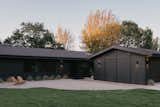Collection by Kathleen Shaeffer Design
Architecture
The home is perched lightly on the site and the landscape has been integrated into the architecture through a sympathetic form and materiality, and the expansive windows. “We long for this untouched nature,” says architect Line Solgaard of the site. “It brings us calmness and maybe even helps us be more in touch with ourselves.”
From the inside, the 45 degree fins facilitate an elegant display of sunlight. “We’re facing west, but because there is a tall building across the street, we’re never going to get direct sunlight into the building,” Shively says.“The best we can do is get sun from the South, and so those fins, although they don't necessarily bounce the light into the building, they themselves glow in the afternoon as the sun comes around that way. It’s a really interesting sculptural thing to appreciate from inside the space.”
Shigeru Ban, Cardboard Cathedral
A testament to the strength, skill, and poignancy of the Pritzker winner’s “emergency architecture,” this A-frame marvel of cardboard tubing and shipping containers served as a potent symbol for Christchurch’s recovery after an earthquake. In another symbolic touch, the stained glass triangle at the front of the church incorporates imagery from the former cathedral’s famous rose window.
The modest two-story studio building occupies the southeastern corner of the property. Downstairs it houses Caryn’s studio, where she shares her enthusiasm for the Alexander Technique with her clients. Upstairs is where Greg and his small team dream up future architectural visions. The building is made of a lightweight steel framework entirely clad in what is traditionally a roofing material: an asphalt-colored shingle, made of only two millimeter-thick recycled rubber sheets, finished with a silicate coating (with a 20-year lifespan). The circular pavers are not actual pavers, but the residue from the pouring of the coffered slabs for House Katz. Instead of letting it go to waste, Greg asked the builders to pour the small amount of concrete left over from each newly mixed batch into a circular container. Once set, these circular shapes were popped out and stored to ultimately become a playful walkway between Caryn and Greg’s studios.
Not only was extra living space necessary for the growing family of four, but the existing house also failed to take advantage of the striking views that drew the couple to the site. The homeowners tapped architect Malcolm Davis of San Francisco–based Malcolm Davis Architecture to redesign and expand the dwelling without damaging the many established oak trees.
With a new baby on the way and the soon-to-be grandmother moving in, Seattleites Ilga Paskovskis and Kyle Parmentier asked Best Practice Architecture to expand their detached garage into a 570-square-foot ADU, which they now call the Granny Pad. “We can see the joy it brings Grandma when the baby comes over to visit,” says Kyle. “It’s the best part of her day.”
57 more saves



















